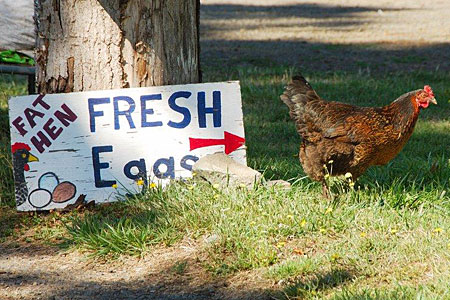
Homegrown eggs are so tasty they are unlikely to sit around long enough to spoil. However, eggs do occasionally go off. Every chicken keeper should know how to tell a good egg from a bad egg.
Why an Egg Goes Bad
A bad egg is generally one that has been contaminated, rendering it inedible or even unsafe. Eggs have built-in natural protection in the form of a thick shell covered with bloom. But neither of these features is entirely impermeable.
Maybe you found the egg on the coop floor or other dirty environment. Always discard a dirty egg, since you can’t tell if bacteria may have already penetrated the shell. And take measures to avoid future dirty eggs, such as encouraging hens to lay in nests and not on the floor, and changing nesting material often enough to keep it clean.
Or maybe the shell has a hairline crack through which bacteria entered. Or the egg could have been partially incubated, as may happen if you discover a hen’s hidden nest. Candling can tell you if an egg has shell cracks or has been partially incubated.
When an Egg Spoils
The easiest way to tell an egg is bad is by the way it smells. A fresh egg, when cracked open, has no odor. A bad egg may have a sour or sulfurous odor. Remember rotten-egg-smelling stink bombs from high school chemistry class? If an egg smells off in any way, toss it.
Not only does such an egg smell bad, it also looks bad. An egg white that’s green, pink, or iridescent likely contains harmful bacteria, rendering it unsafe to eat. Likewise, discard an egg with a discolored or mottled yolk.
Normal Egg White Variations
In a fresh egg, the white is firm, not runny, and yolk does not easily break. As an egg ages, it spreads out more when cracked into a pan and the yolk may break. That doesn’t mean the egg is bad. It’s just a sign that the egg is aging, but it’s still good.
Egg white is normally either cloudy or clear. Cloudiness comes from carbon dioxide, and is a sign that the egg is ultra fresh. As the egg ages, the carbon dioxide releases and the white clears. The egg is no longer at its freshest, but is still good to eat.
Egg white contains two small white string-like things, called chalazae, that are actually a type of egg white. During an egg’s formation inside the hen, the chalazae anchor the yolk to the cell membrane to center it within the white. When you break an egg out of its shell, the chalazae snap away from the shell membrane and recoil against the yolk. This, too, is perfectly normal.
Normal Egg Yolk Variations
Small red spots on the yolk are blood spots that can occur when a blood vessel bursts as a hen’s body releases a yolk to start the development of a new egg. These spots are extremely common. The reason you don’t find them in eggs purchased in a carton is that they have been candled to remove any with this imperfection. Blood spots in no way affect an egg’s safety or edibility.
A normal yolk can vary in color from pale yellow to reddish orange. This color variation reflects what the hen has been eating in terms of xanthophyll and carotene plant pigments. Zanthophylls, such as from alfalfa, result in a yellow yolk, while carotenes, as in corn, produce a darker yolk. Free range hens typically lay eggs with darker yolks.
Bottom line: When an egg goes bad, you’ll know it by the way it looks and, especially, smells. Meanwhile, just keep enjoying those delicious homegrown eggs from your backyard hens.
And that’s today’s news from the Cackle Coop.
Gail Damerow is the author of Storey’s Guide to Raising Chickens.

